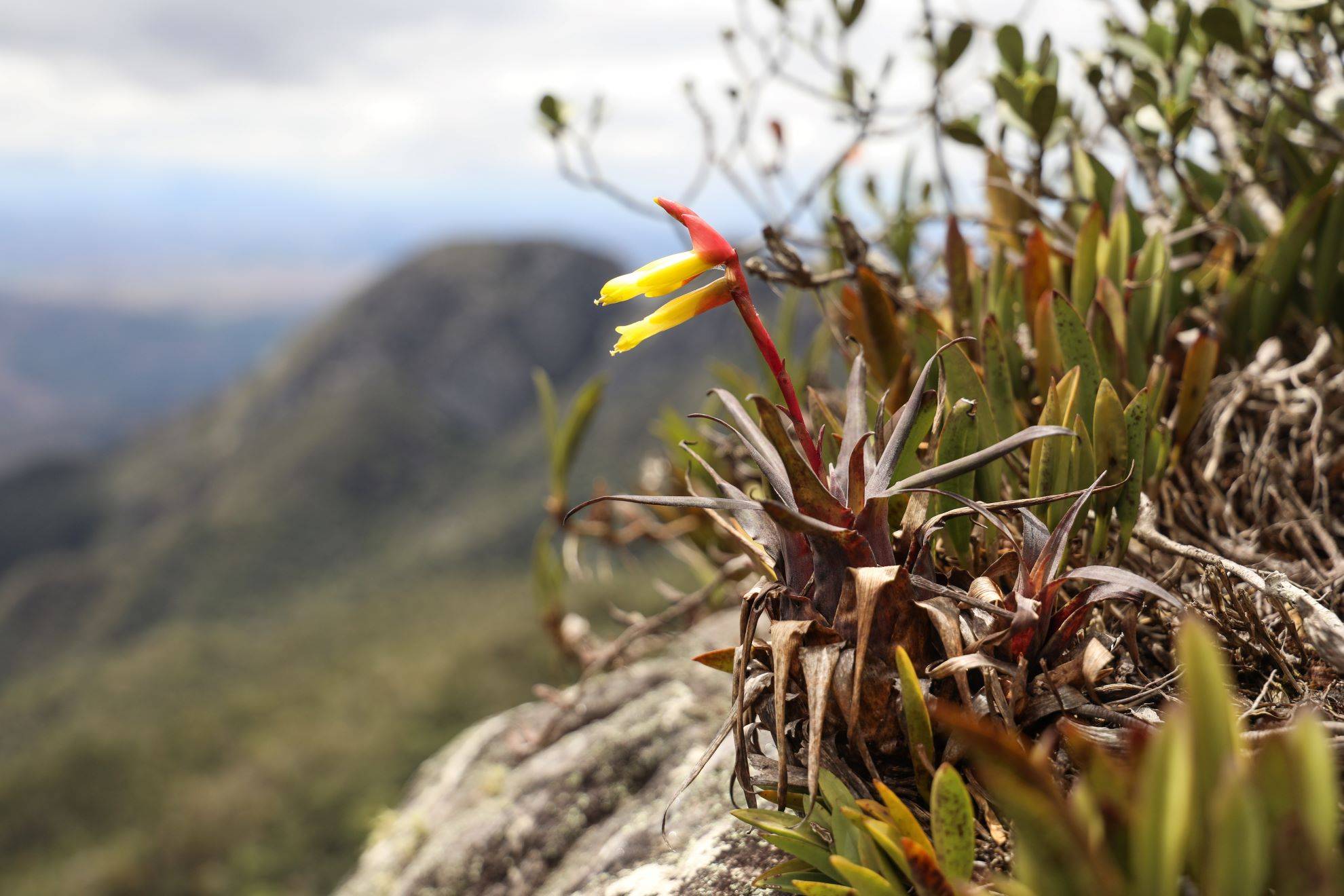Where scientists expected to see a pale, bland specimen, a vibrant yellow and red flower emerged. And at that moment, before the eyes of science, a new species – and a new riddle – bloomed. The discovery of the enigmatic bromeliad (Stigmatodon enigmaticus) in the mountains of Minas Gerais, southeast of Brazil, now challenges what biologists know about this botanical genus, and instigates researchers to piece together clues to unravel the evolutionary history of this new, singular plant.
The finding was made during expeditions of the “Rupicolous Ecosystems of the Atlantic Forest” project, carried out by the National Institute of the Atlantic Forest (INMA). The plant was found 1.200 meters above sea level in Serra do Pinhão, an elevated region that is part of the mountain range known as Serra do Padre Ângelo, in the municipality of Conselheiro Pena, state of Minas Gerais. It inhabits rocky outcrops in rupestrian fields, an environment favorable to singularities and unique species.
The enigmatic bromeliad donned no flowers in its first encounter with researchers, in May 2021. The botanists examined its purplish leaves, covered in small white scales typical of the genus Stigmatodon, which is composed of bromeliads well adapted to life on mountain rocks of the Atlantic Forest Biome. Flowers of this group were known to bloom at night, to lack vivid colors, and to have bats as their main pollinators.
But contrary to the scientists’ expectations, the bromeliad blossomed in intense colors. “We were looking forward to the plant blooming, and we imagined it would have whitish or greenish flowers, like all other Stigmatodon species. We were very surprised, however, when the plant flowered during the day, and with such vibrant colors. Its flowers are yellow with external structures – called bracts – of vivid red, characteristics usually associated with pollination by hummingbirds and common in the genus Vriesea, the sister group of Stigmatodon,” explains Dayvid Couto, researcher at INMA and leading author of the study published in February in the journal Phytotaxa.

Although its flowers contradict everything known about Stigmatodon, all other morphological traits observed by the botanists validated the classification of the enigmatic bromeliad within the genus. “But future studies using DNA and plant anatomy will help us test evolutionary hypotheses about this floral trait and the placement of this species within its genus,” says Dayvid.
While searching for answers about the enigmatic bromeliad’s past, researchers worry about its future. Known to exist in a single locality in Serra do Pinhão, the species is considered “microendemic”, with an estimated occurrence area of only 4 km2, less than 20 mature individuals, and no conservation unit to protect its tiny habitat. For these reasons, the team of scientists suggest that the plant should already be classified as critically endangered, the highest degree of threat recognized by the IUCN.
The biggest threat to the bromeliad’s future is fire, frequently used by surrounding landowners to renovate their pastures, and the invasion of exotic species such as molasses grass and ferns of the genus Pteridium, which advance over the territory of native flora.
To protect the enigmatic bromeliad and several other species that live in the region – where more than 30 species have been described in the last decade alone, 26 of which are endemic – researchers are working in a proposition to create a Natural Monument that will protect the two massifs of Serra do Padre Ângelo as well as Pico da Aliança, another peak located in the municipality of Alvarenga.


“The idea behind making it a Natural Monument is that the area is fragmented and contains several private properties, little farms that couldn’t be included in a different category of protection,” says Paulo Gonella from Universidade Federal de São João Del-Rei (UFSJ), another author of the study.
Also, the municipality of Conselheiro Pena, where the enigmatic bromeliad was discovered, is itself considering the creation of a municipal park to protect the part of the mountain range in its territory.
One of the objectives of the INMA project is precisely to catalog the biodiversity of rocky environments and collect data to subsidize the creation of public policies meant to assist in their conservation.
“We want to draw attention to the area, to how it is unprotected, that this great diversity of plants and animals is unprotected. And also to the people of the region: the importance of this conservation area for the transformation of the local economy, and for a more sustainable tourism,” concludes the researcher.
*Original text translated from portuguese by Bernardo Araújo
Leia também

How Brazil is working to save the rare lion tamarins of the Atlantic Forest
Golden lion tamarin conservation efforts have been successful, growing the population from a one-time low of 200 animals to more than 2,000 today. →

From tropical forest explorer to nature defender
Renowned primatologist Russell Mittermeier reveals that Tarzan was the hero of his childhood and, along a couple of adventurous naturalists, his inspiration for a life-long career as a conservationist →

Brazil’s Atlantic Forest gets a chance at a fresh start through restoration
Over the past five centuries, the Atlantic Forest has been exploited, occupied and gradually exterminated. A biome that once stretched along almost the entire coastline of Brazil has given way to cities where 70% of the country’s population today lives. What remains of the forest is just a fraction of what it used to be. →









